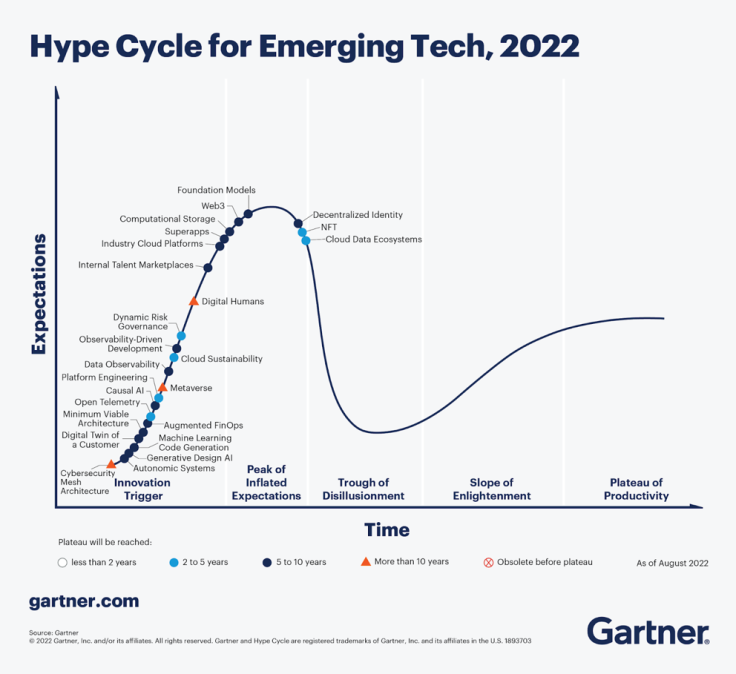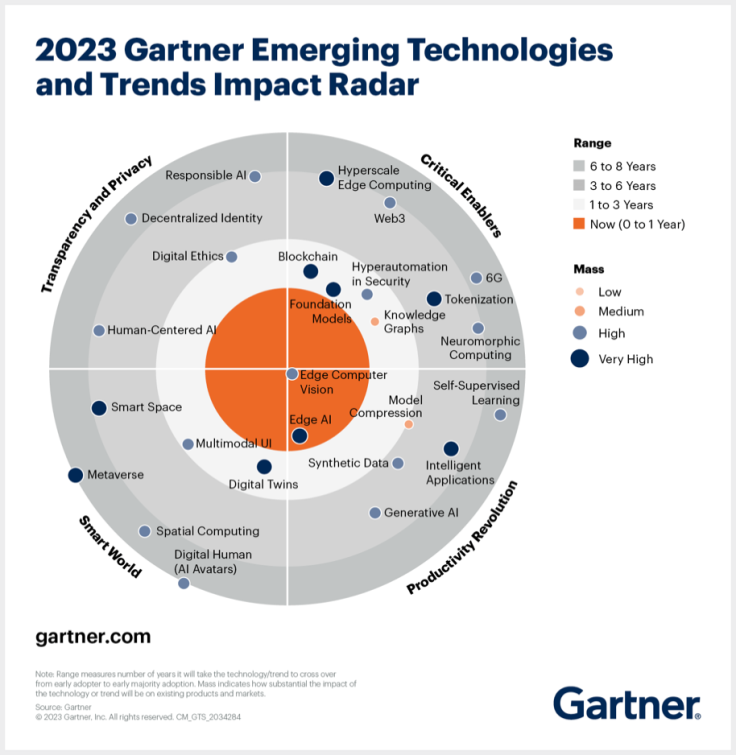
Rapid Change in the Development Paradigm
The mobile application development market has been growing swiftly since its inception, and in the coming years, we can anticipate an even faster acceleration. Statista estimates that the global app market revenue in 2022 is around $430.90 billion, and over the next five years, an average annual growth of 6.91% is projected. As a result, the expected market size will reach $641.10 billion in 2027.
This expansion in volume and the exploration of new software application areas lead to a rise in the number and quality of technologies utilized. These technologies are used for both the functioning of applications and their development process. Some of them appear on Gartner's Hype Cycle charts. While many of them surpass the peak of "hype expectations," not all reach the final "productivity plateau."

For companies in the development industry that aim to maintain and enhance their competitiveness, it is crucial to monitor emerging trends from their inception and invest in them timely, while also avoiding an over-reliance on hype. One example is the metaverse, which initially garnered significant hype but failed to achieve widespread success, with the exception of virtual characters in South Korean K-pop culture.
In 2023, Gartner's Emerging Tech Impact Radar highlights technologies like edge computer vision systems and edge artificial intelligence. While it is currently challenging to evaluate the commercial potential of these solutions, incorporating them into a technology portfolio or considering them as development tools is vital for a company's future success.

A key characteristic of the contemporary development market is the swift evolution of customer needs. As a result, it is crucial to utilize innovative tools like remote management, AI, and content creation apps for building and updating apps quickly without compromising quality.
Predicting the future development of any technology based on current trends is always challenging, especially in the development industry. However, there are some areas with considerable potential, at least in 2023.
Factors Impacting the Development Market
To accurately assess promising technologies, it is helpful to examine current technologies that have confidently entered commercialization and are prepared to become a platform for generating new ideas:
Ubiquitous Mobility: Today, even the most economically disadvantaged populations in developing countries have increasing access to gadgets. The demand for mobile technology in the corporate sector was further validated during the pandemic.. Affordable tariffs from telecom operators lower the cost of network access, leading to a larger subscriber base and an increase in app downloads. . Developers must ensure app compatibility with various platforms and generations and consider regional nuances.
5G and Wi-Fi 6 Networks: The proliferation of these networks will inevitably increase the demand for heavier multimedia content and enhance the popularity of mobile services such as social networks, video conferencing, mobile banking, and corporate applications. Developers who can create and offer innovative ideas for high-speed network subscribers, such as effective data analysis and usage, will find new growth opportunities.
Foldable and Wearable Devices: These gadgets provide additional user opportunities and are increasingly sought after not only for entertainment but also in the industry. A reimagined approach to UI/UX development is often essential. The expanded use of gyroscopes, accelerometers, and other sensors in gadgets enables new possibilities in applications, including those with AR/VR functionality.
Augmented Reality (AR) and Virtual Reality (VR): These technologies have moved beyond gaming applications and are now used in education, medicine, simulation, retail, e-commerce, and other sectors.
Internet of Things (IoT) Evolution: IoT is moving towards applications for devices that gather diverse data and can analyze it even at the network edge (Edge). Applications that quickly adapt to user preferences, including utilizing settings and data from other devices, are in demand. Developers must explore new ways to build applications for home automation systems, healthcare, and transportation while addressing growing security and privacy concerns.
Artificial Intelligence (AI) and Machine Learning (ML): Already widespread, the use of AI and ML in various applications will continue to intensify in 2023.
Mobile E-commerce: The rapid growth of mobile e-commerce necessitates the expanded use of virtual demonstration technologies for products and services, as well as the integration of modern mobile banking models to enhance transaction security and protect personal data.
Sector-Specific Mobile Apps: Mobile apps for e-commerce, healthcare, and education experienced significant download growth during the COVID-19 lockdown. In 2023, the greatest potential in mobile development will continue to lie in communication, telemedicine, work, study, social networking, and entertainment applications.
Key Focus Areas for the Near Future
Numerous innovations that have demonstrated their value in the commercialization process will continue to enhance their effectiveness in 2023:
1. AI and ML in application development: In 2023, pay attention to the following aspects:
Deeper personalization techniques for data analysis and user behavior, providing more targeted recommendations, notifications, and content.
Improved NLP algorithms for voice command development and chatbots with human speech processing.
Image and video recognition algorithms for analysis, advanced image retrieval, face recognition, and AR/VR technologies.
Predictive analytics algorithms for marketing campaigns and personalized solutions.
Automation of routine development tasks, allowing developers to focus on complex problems.
2. Cloud infrastructure: This improves business intelligence, process agility, scalability, and leads to faster customer support, reducing costs and time to market. Cloud integration will develop towards:
Seamless connections between distributed systems.
Faster, more reliable data access on local and remote servers.
Adoption of SaaS, DBaaS, and other schemes for analytics platforms, CRM, and other applications, furthering the trend of moving away from physical data storage and processing equipment.
3. Blockchain technology: In 2023, expect an increase in blockchain applications in finance, healthcare, logistics, and social networks. Blockchain offers the greatest prospects when working with decentralized application (dApp) models.
4. Beacon technology: In 2023, this technology will expand the capabilities of mobile apps, with significant potential in retail, healthcare, and tourism. For developers, the instant notification function when users enter the beacon's coverage area may be most interesting. Beacons can also serve as a tool for proximity marketing. Statista predicts the beacon technology market will be worth $56.6 billion by 2026, with a CAGR of 59.8%.
5. On-demand apps: These apps, exemplified by Airbnb and Uber, will continue to develop in 2023, providing new opportunities for businesses in telemedicine, online training, food delivery, remote technical support, fitness, beauty salons, and other on-demand services.
6. Instant apps: These allow users to try applications without downloading the full version and will continue to gain popularity. In 2023, expect even more lightweight app versions on the Google Play Store, potentially becoming a must-have trend for mobile development.
Key Development Trends
The main technological areas currently exerting the most significant impact on mobile application development tools and techniques include:
The increasing popularity of cloud-based development platforms like Appcelerator Titanium, Adobe PhoneGap, and Xamarin. These platforms enable developers to quickly build, test, and deploy mobile apps directly to the cloud.
The widespread adoption of the latest HTML5 and CSS3 standards for web development, offering improved performance and expanded possibilities for UI/UX design.
The rising demand for open-source libraries and frameworks, such as jQuery Mobile, Ext JS, and React Native, among mobile developers.
Conclusion
In 2023, the field of application development is expected to experience numerous new developments. This will likely result in strong growth in customer demand, further driving the adoption of new technologies.
Application development companies should be prepared to address new and unexpected needs in both consumer and enterprise sectors, requiring innovative ideas and leading to emerging development tool trends.
Ignoring new trends in mobile application development may jeopardize even the most successful projects. While it is not essential to incorporate every innovation into each product, staying up-to-date with new technologies is crucial for rapidly adapting to changes in market demand.










